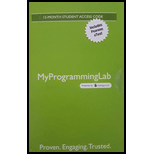
MYPROGRAMMINGLAB WITH PEARSON ETEXT
8th Edition
ISBN: 9780134225340
Author: Deitel
Publisher: PEARSON
expand_more
expand_more
format_list_bulleted
Question
Chapter 5, Problem 5.50MD
Program Plan Intro
- Ask the student to enter the two numbers and validate his answer by creating a function multiply().
- Display the question repeatedly until the student gives the correct answer.
- Display the message every time to inform the student whether his/her answer is correct or incorrect.
- Call the function multiply() from the main and display the result.
Summary Introduction- The program instructs and elementary school student to learn the multiplication.
Program Description- The purpose of the program is to give the instruction to an elementary school student such that he/she can learn the multiplication. The program uses the function multiply(int, int) which takes two integers and multiplies them, the student tells the answer, if the answer matches, it displays the answer is correct otherwise instructs the student to try again.
Expert Solution & Answer
Want to see the full answer?
Check out a sample textbook solution
Students have asked these similar questions
I need to define and discuss the uses of one monitoring or troubleshooting tool in Windows Server 2019. thank you
I would likr toget help with the following concepts:
- Windows Server features
- Windows Server versus Windows 10 used as a client-server network
I need to define and discuss the uses of one monitoring or troubleshooting tool in Windows Server 2019. thank you
Chapter 5 Solutions
MYPROGRAMMINGLAB WITH PEARSON ETEXT
Ch. 5 - Show the value of x after each of the following...Ch. 5 - (Parking Charges) A parking garage charges a $2.00...Ch. 5 - (Rounding Numbers) An application of function...Ch. 5 - (Rounding Numbers) Function floor may be used to...Ch. 5 - Write statements that assign random integers to...Ch. 5 - For each of the following sets of integers, write...Ch. 5 - (Hypotenuse Calculations) Define a function called...Ch. 5 - (Exponentiation) Write a function...Ch. 5 - Prob. 5.17ECh. 5 - Prob. 5.18E
Ch. 5 - Prob. 5.19ECh. 5 - (Displaying a Square of Any Character) Modify the...Ch. 5 - Prob. 5.21ECh. 5 - (Separating Digits) Write program segments that...Ch. 5 - (Time in Seconds) Write a function that takes the...Ch. 5 - (Temperature Conversions) Implement the following...Ch. 5 - (Find the Minimum) Write a function that returns...Ch. 5 - (Perfect Numbers) An integer number is said to be...Ch. 5 - Prob. 5.27ECh. 5 - (Reversing Digits) Write a function that takes an...Ch. 5 - (Greatest Common Divisor) The greatest common...Ch. 5 - (Quality Points for Students Grades) Write a...Ch. 5 - (Coin Tossing) Write a program that simulates coin...Ch. 5 - (Guess the Number) Write a C program that plays...Ch. 5 - (Guess the Number Modification) Modify the program...Ch. 5 - (Recursive Exponentiation) Write a recursive...Ch. 5 - (Fibonacci) The Fibonacci series 0, 1, 1, 2, 3, 5,...Ch. 5 - (Towers of Hanoi) Every budding computer scientist...Ch. 5 - Prob. 5.37ECh. 5 - Prob. 5.38ECh. 5 - Prob. 5.39ECh. 5 - Prob. 5.40ECh. 5 - (Distance Between Points) Write a function...Ch. 5 - Prob. 5.42ECh. 5 - Prob. 5.43ECh. 5 - After you determine what the program of Exercise...Ch. 5 - (Testing Math Library Functions) Write a program...Ch. 5 - Find the error in each of the following program...Ch. 5 - Prob. 5.47ECh. 5 - (Research Project: 1m proving the Recursive...Ch. 5 - (Global Warming Facts Quiz) The controversial...Ch. 5 - Prob. 5.50MDCh. 5 - Prob. 5.51MDCh. 5 - (Computer-Assisted Instruction: Monitoring Student...Ch. 5 - (Computer-Assisted Instruction: Difficulty Levels)...Ch. 5 - (Computer-Assisted Instruction: Varying the Types...
Knowledge Booster
Similar questions
- Please solve and answer the questions correctly please. Thank you!!arrow_forwardConsidering the TM example of binary sum ( see attached)do the step-by-step of execution for the binary numbers 1101 and 11. Feel free to use the Formal Language Editor Tool to execute it; Write it down the current state of the tape (including the head position) and indicate the current state of the TM at each step.arrow_forwardI need help on inculding additonal code where I can can do the opposite code of MatLab, where the function of t that I enter becomes the result of F(t), in other words, turning the time-domain f(t) into the frequency-domain function F(s):arrow_forward
arrow_back_ios
SEE MORE QUESTIONS
arrow_forward_ios
Recommended textbooks for you
 C++ for Engineers and ScientistsComputer ScienceISBN:9781133187844Author:Bronson, Gary J.Publisher:Course Technology Ptr
C++ for Engineers and ScientistsComputer ScienceISBN:9781133187844Author:Bronson, Gary J.Publisher:Course Technology Ptr C++ Programming: From Problem Analysis to Program...Computer ScienceISBN:9781337102087Author:D. S. MalikPublisher:Cengage Learning
C++ Programming: From Problem Analysis to Program...Computer ScienceISBN:9781337102087Author:D. S. MalikPublisher:Cengage Learning Microsoft Visual C#Computer ScienceISBN:9781337102100Author:Joyce, Farrell.Publisher:Cengage Learning,
Microsoft Visual C#Computer ScienceISBN:9781337102100Author:Joyce, Farrell.Publisher:Cengage Learning,

C++ for Engineers and Scientists
Computer Science
ISBN:9781133187844
Author:Bronson, Gary J.
Publisher:Course Technology Ptr

C++ Programming: From Problem Analysis to Program...
Computer Science
ISBN:9781337102087
Author:D. S. Malik
Publisher:Cengage Learning

Microsoft Visual C#
Computer Science
ISBN:9781337102100
Author:Joyce, Farrell.
Publisher:Cengage Learning,